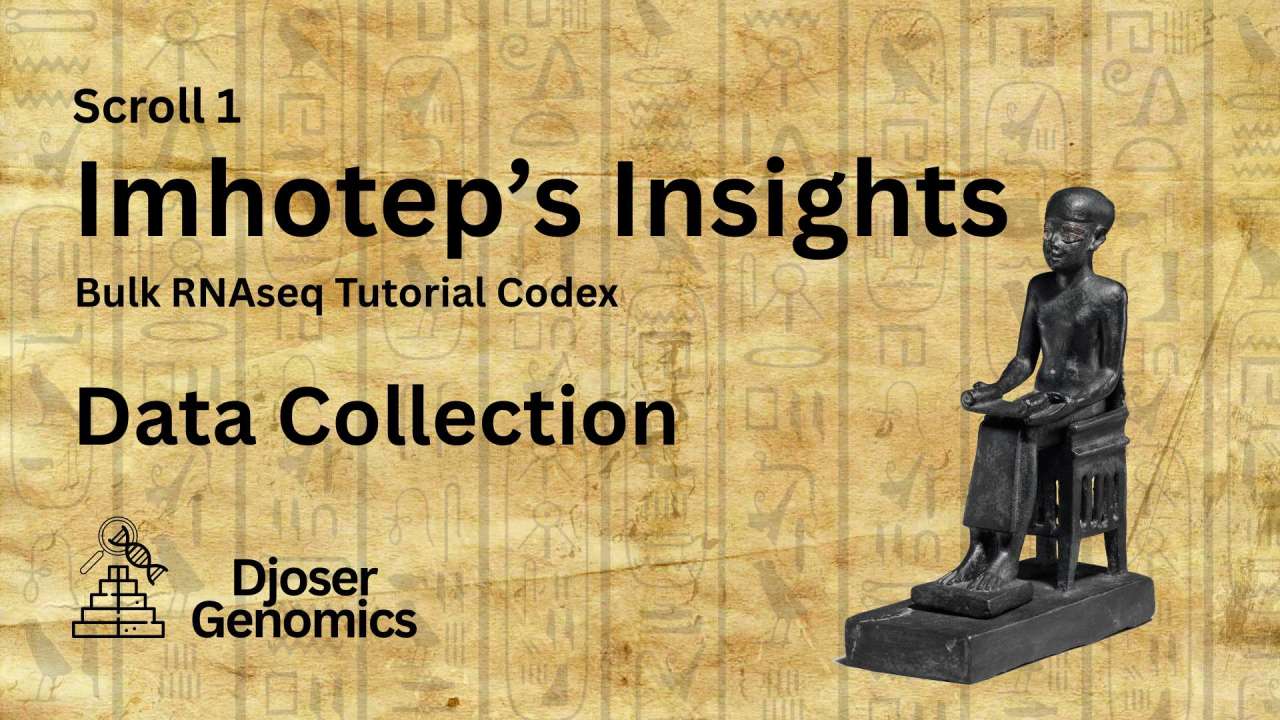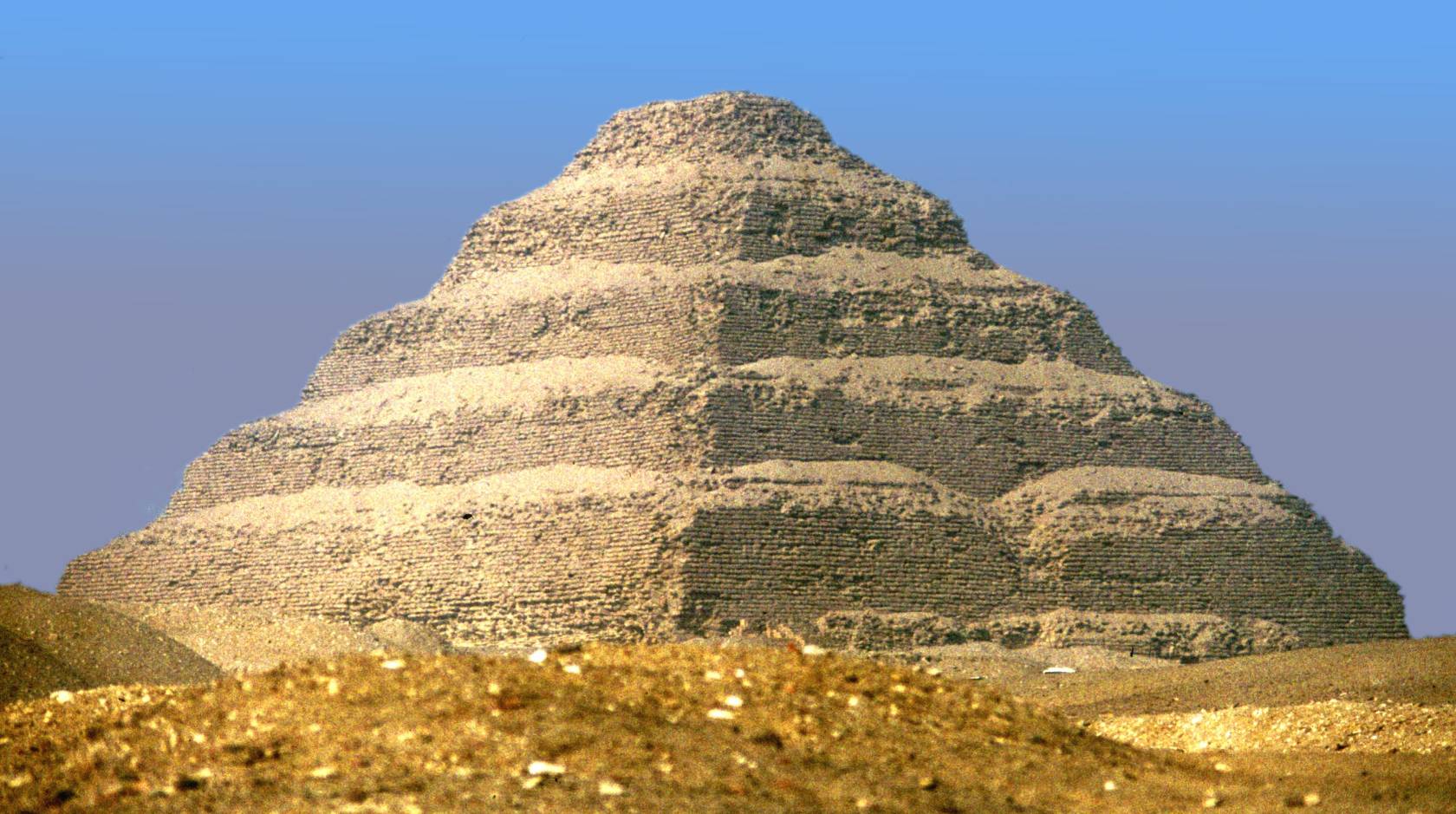Scroll 1: Imhotep's Insights

Welcome to Scroll 1 of 8, from the Djoser’s Bulk RNAseq Tutorial Codex, a collection imagined as if preserved from the ancient halls of knowledge.
This first scroll opens with the foundational act: collecting real RNA-seq data for analysis, much like laying the first stones in a structure. It is said that all great endeavors begin with order; perhaps even Imhotep would have agreed.
📜 Scroll Objectives
- Finding Real RNA-seq Datasets
- Dataset Used in This Tutorial
- Downloading the Data in Google Colab
- Cultural Spotlight: Imhotep & the Legacy of Saqqara
Step 1: Finding Real RNA-seq Datasets
Before diving into bioinformatics tools, we need real-world RNA-seq data to work with.
There are multiple public databases that host such data, including:
- ENA (European Nucleotide Archive)
- NCBI SRA (Sequence Read Archive)
- GEO (Gene Expression Omnibus)
Each of these databases contains raw sequencing data submitted by researchers worldwide, often linked to published papers.
For this tutorial, we’ll use ENA.
You can explore ENA at:
🔗 https://www.ebi.ac.uk/ena/browser/home
To find datasets, try searching with keywords like:
"Homo sapiens RNA-seq"- or directly by project ID, such as
PRJNA967653
Each project page provides sample descriptions and links to raw .fastq.gz files that we can download.
💡 Tip: When you’re just starting out, it’s a good idea to work with datasets that have around 6–8 samples, small enough to process quickly, but large enough to learn meaningful concepts.
Dataset Used in This Tutorial
We’ll use a publicly available human dataset from ENA Project PRJNA967653, which examines gene expression changes in human superior cervical ganglia with and without cardiac diseases.
We’ll be using the following 6 samples:
- SRR24448335 (Cardiac Disease)
- SRR24448336 (Cardiac Disease)
- SRR24448337 (Cardiac Disease)
- SRR24448338 (Healthy)
- SRR24448339 (Healthy)
- SRR24448340 (Healthy)
In addition to the RNA-seq reads, we’ll use the reference human transcriptome (cdna) (FASTA format) from Ensembl (no need to download now - we will download it in step 2).
- Go to Ensembl
- Choose the Human Genome
- From Gene annotation Choose Download FASTA files for genes, cDNAs, ncRNA, proteins
- Choose cdna folder
- Download the file:
Homo_sapiens.GRCh38.cdna.all.fa.gz
This file contains all known coding transcripts (mRNAs) for Homo sapiens, and it will be used in the alignment step to match our reads to known genes.
Step 2: Downloading the Data in Google Colab
We’ll be running everything inside Google Colab, a free, cloud-based Jupyter notebook that supports Python and shell commands, making it perfect for bioinformatics tutorials.
Open a new Colab notebook and follow along step by step.
1. Create a Directory for Your Data
This block of code creates a folder inside Colab’s virtual environment to store the RNA-seq data we’ll download.
1
2
3
4
5
6
7
import os
folderPath = '/content/RNAseq'
# Create the directory if it doesn't exist
if not os.path.exists(folderPath):
os.makedirs(folderPath)
2. Define the Download URLs
Now we list all the datasets and the reference transcriptome file that we want to download:
1
2
3
4
5
6
7
8
9
datasets = [
'ftp://ftp.sra.ebi.ac.uk/vol1/fastq/SRR244/035/SRR24448335/SRR24448335.fastq.gz',
'ftp://ftp.sra.ebi.ac.uk/vol1/fastq/SRR244/036/SRR24448336/SRR24448336.fastq.gz',
'ftp://ftp.sra.ebi.ac.uk/vol1/fastq/SRR244/037/SRR24448337/SRR24448337.fastq.gz',
'ftp://ftp.sra.ebi.ac.uk/vol1/fastq/SRR244/038/SRR24448338/SRR24448338.fastq.gz',
'ftp://ftp.sra.ebi.ac.uk/vol1/fastq/SRR244/039/SRR24448339/SRR24448339.fastq.gz',
'ftp://ftp.sra.ebi.ac.uk/vol1/fastq/SRR244/040/SRR24448340/SRR24448340.fastq.gz',
'https://ftp.ensembl.org/pub/release-114/fasta/homo_sapiens/cdna/Homo_sapiens.GRCh38.cdna.all.fa.gz'
]
Explanation:
- These are direct FTP/HTTP links to
.fastq.gzfiles from ENA and the transcriptome FASTA file from Ensembl. - We’ve listed the links inside a Python list so we can loop over them next.
3. Download Each File
Now we loop over each URL and download the corresponding file using wget.
1
2
3
4
5
6
7
8
9
for url in datasets:
filename = url.split("/")[-1]
!wget "$url" -P "$folderPath"
file_path = os.path.join(folderPath, filename)
if os.path.exists(file_path):
print(f"✅ Downloaded: {filename}")
else:
print(f"❌ Failed to download: {filename}")
Explanation:
filename = url.split("/")[-1]: extracts the file name from the URL.!wget "$url" -P "$folderPath": downloads the file using the Unixwgetcommand directly inside Colab.- We use
os.path.exists()to check whether the download was successful and print a confirmation message.
After running this step, your /content/RNAseq folder in Colab should contain:
- 6
.fastq.gzRNA-seq files - 1
.fa.gztranscriptome reference file
That’s everything covered in Imhotep’s Insights Scroll.
In this scroll, we gathered real RNA-seq data from ENA and prepared it for analysis in Google Colab, following the same foundational steps researchers take every day in transcriptomics workflows.
If you want to continue, head over to the next scroll: Hesy-Ra’s Diagnostics, where we’ll perform Quality Control
Let’s now shift gears from code to culture in our Cultural Spotlight below.
🏛️ Cultural Spotlight: Imhotep & the Legacy of Saqqara
Imhotep is one of the most remarkable figures in ancient Egyptian history. Serving under Pharaoh Djoser, he was a polymath, an architect, high priest, physician, and adviser. Though not a scientist in the modern sense, his legacy in organizing knowledge and healing earns him symbolic credit here as a timeless figure of structure and insight.
He is best known for designing the Step Pyramid of Saqqara, considered the first monumental stone building in human history, a revolutionary act of precision, planning, and foresight.
The legacy of Imhotep, Djoser (Will show up in a future scroll ;D) and the Step Pyramid of Djoser at Saqqara is what inspired Djoser Genomics. It’s a reminder that every structure (ancient or scientific) begins with a strong, thoughtful foundation, step by step.
Papyrus Background from the Post’s Cover photo is from Freepik

